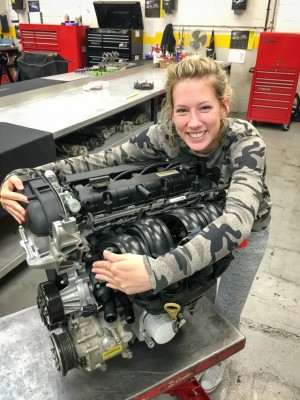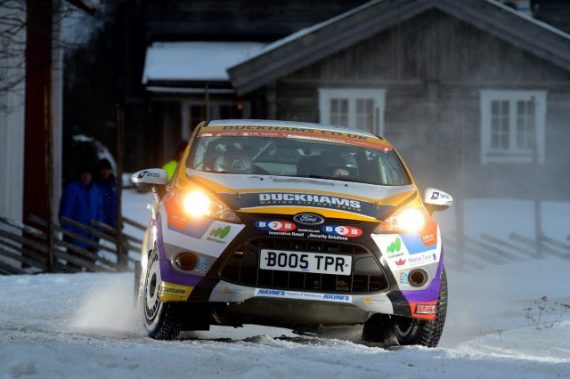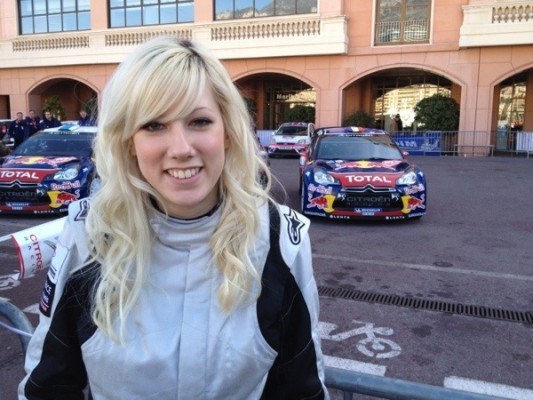Louise Cook returned to World competition last weekend after enduring a four year absence from the sport.
Louise, despite becoming the first female in the world to gain a FIA Rally Championship title in 2012, has struggled ever since to gain the funding needed to compete at world level. Then, at just the time when enough funding was found for two rounds in 2015, a screw was found to be compressing Louise’s subclavian artery from a collar bone plate, forcing her again away from competition and sadly suffering financial loss from committed costs in the process.
Louise, all fixed, found just enough funding to compete on WRC Neste Rally Finland this weekend. This was to be the Kent driver’s 18th rally, but once again it nearly didn’t happen.
Louise had competed on a promotional event, Goodwood Festival of Speed, a couple of weeks prior to Rally Finland where the car was running fine but with an intermittent misfire. The misfire seemed to be getting slightly worse but then quickly developed into a show stopper. Louise and her team started the process of elimination and with the life of the auxiliary components unknown and the engine only just being rebuilt before purchase, it made sense that an electrical ancillary or sensor could be at fault.
“We changed usual components like spark plugs, leads and coil then went on to engine management components like throttle body, fuel pump, engine sensors etc but nothing was improving the misfire.”
“It wasn’t until we checked the crank sensor that things started to unfold. The crank shaft sensor had been damaged.”
The crankshaft end float which allows the engine to spin was way out of tolerance. The crankshaft had a whopping 3.2mm end float, a measurement which should usually be only 0.3mm. This meant that the crank sensor had been eaten alive by the flywheel and was causing the misfire, not a simple fix. The engine now needed a full rebuild and with only five days until the team had to leave, Rally Finland was looking near impossible.
“We needed a miracle; I called Mountune Racing in Essex for some advice on the engine. They said to bring it down to them as soon as possible. We got it out the car and managed to get it to them by the afternoon.”
The guys at Mountune stayed on and stripped the engine down that Thursday evening. They found the thrust bearing had been destroyed and the crank shaft was damaged. It was now beyond a rebuild, it would need a new crankshaft and perhaps an engine block. Louise had a pre-event test scheduled for the Saturday to get back into things after such a long absence from the sport which had to be cancelled and the team was meant to be leaving the following Wednesday for the rally.
Mountune amazingly had a brand new base engine in the workshop that they could use to build a race engine.
“Mountune turned the engine around in a day. I honestly do not know how they did it! Rally Finland was back on, they truly kept the dream alive!”
Mountune found that the previous engine builder had fitted a bush in the end of the crankshaft that was too long, meaning that when the gearbox was bolted to the engine, pressure was being placed on the crankshaft and grinding away at the thrust bearing and engine. Mountune removed the bush from the new build.
“It was important to find the problem and not just fix the engine. When the causes are unknown, you can soon end up back in the same place. The crankshaft bush was a simple oversight from the previous engine builder with disastrous consequences. If Mountune hadn’t spotted the cause then it would have killed another engine.”
“I knew when we had the serious engine problem that I would not be able to drive the car before the rally. It was a new car so it was a big part of the plan to get used to it, set it up the way I wanted and just get confidence before going into competition and driving flat out. I know a lot of people would have decided to pull out of the event at this point and it would have been the logical thing to do, but I needed to be back in the WRC and at Rally Finland. We agreed we would all work flat out and do everything we could to make it. We changed the ferry to the latest possible departure to be able to be in Finland to sign on for the rally in time.”
The crew worked day and night for 7 days without sleep. Some going to their daily jobs then working through the night on the rally car. The engine was installed, started up and driven just 15 miles before being loaded onto the trailer and leaving straight for the ferry 3 days behind the original planned departure. |









